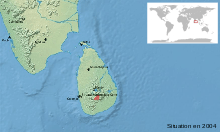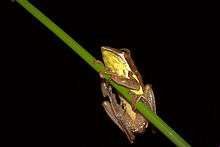Taruga eques
Taruga eques (common names: Günther's whipping frog, montane hour-glass tree-frog) is a species of frog in the family Rhacophoridae. It is endemic to the central hills of Sri Lanka.[1][2][3]

| Taruga eques | |
|---|---|
 | |
| Scientific classification | |
| Kingdom: | Animalia |
| Phylum: | Chordata |
| Class: | Amphibia |
| Order: | Anura |
| Family: | Rhacophoridae |
| Genus: | Taruga |
| Species: | T. eques |
| Binomial name | |
| Taruga eques (Günther, 1858) | |
 | |
| Synonyms[2] | |
|
Polypedates eques Günther, 1858 | |
Description
Adult males measure 33–43 mm (1.3–1.7 in) and females 59–71 mm (2.3–2.8 in) in snout–vent length. It resembles (and has been confused with) Taruga fastigo but has relatively shorter legs, narrower but longer head, an by the absence of the black line that connects the axilla and groin in Taruga fastigo, or that line being reduced to a band of blackish dots.[3]. Taruga eques can be differentiated from the species included to the same genus with the presence of Calcar on the heel.[4]
Habitat and conservation
Taruga eques inhabits montane tropical moist forests at elevations of 1,200–2,135 m (3,937–7,005 ft) above sea level. It is both arboreal and terrestrial, being found in the canopy and on tree trunks as well as in grasses at the edge of ponds. The tadpoles occur in both permanent and seasonal ponds. It does not occur in modified habitats. While a common species, it is threatened by habitat loss caused by the conversion of forest to agricultural use, forestry, fires, and infrastructure development. It is present in the Horton Plains National Park, Hakgala Strict Nature Reserve, and the Peak Wilderness Sanctuary.[1]
_at_Horton_Plains_National_Park.jpg)
Polymorphism
Polymorphism is defined as “arising of two or more distinct forms simultaneously in the same habitat of a species in such proportions that the rarest of them cannot be maintained by recurrent mutation’’. [5] According to an amphibian survey carried out in World Heritage Horton Plains National Park revealed that Taruga eques possess diverse colour and pattern polymorphism as other tree frogs in the world. Six dorsal colour variations and five different pigment patterns have been discovered in this study.[6]
References
.jpg)
- Manamendra-Arachchi, K.; de Silva, A. & Wickramasinghe, D. (2004). "Taruga eques". IUCN Red List of Threatened Species. 2004: e.T58946A11860421. doi:10.2305/IUCN.UK.2004.RLTS.T58946A11860421.en.
- Frost, Darrel R. (2017). "Taruga eques (Günther, 1858)". Amphibian Species of the World: an Online Reference. Version 6.0. American Museum of Natural History. Retrieved 4 June 2017.
- Manamendra-Arachchi, Kelum; Pethiyagoda, Rohan (2001). "Polypedates fastigo, a new tree frog (Ranidae: Rhacophorinae) from Sri Lanka" (PDF). Journal of South Asian Natural History. 5: 191–199.
- De Silva, Anslem (2009). Amphibians of Sri Lanka: A Photographic Guide to Common Frogs, Toads and Caecilians (1st ed.). Kandy: Privately published. p. 125. ISBN 978-955-52061-0-5.
- {{cite journal |last1=Ford |first1=EB |title=Polymorphism |journal=Biological Reviews |date=1945 |page=73-88 |doi=https://doi.org/10.1111/j.1469-185X.1945.tb00315.x |10.1111
- Silva G.K.V.P.T., & Mahaulpatha W.A.D., (2019). "Distribution of colour and Pattern polymorphism in montane frogs of Sri Lanka". ournal of Entomology and Zoology Studies. 7 (2): 486–491.CS1 maint: extra punctuation (link) CS1 maint: multiple names: authors list (link)


